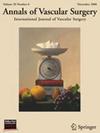An 8-Year Experience of Robot-Assisted Laparoscopic Surgical Management of Median Arcuate Ligament Syndrome
IF 1.4
4区 医学
Q3 PERIPHERAL VASCULAR DISEASE
引用次数: 0
Abstract
Background
Due to the rarity of median arcuate ligament syndrome (MALS), surgical approaches to median arcuate ligament release (MALR) have been understudied. This series aimed to review robot-assisted laparoscopic MALR from a quaternary care center.
Methods
This is a single-center cohort study of adult patients who underwent robot-assisted laparoscopic MALR between March 2015 and June 2023. Clinicopathologic data were abstracted from the electronic medical record for patients with at least 30 days of follow-up. Our primary outcome was symptom improvement, which was assessed via review of the medical record from postoperative patient visits with a provider. Bivariate analyses were performed using Fisher's exact test.
Results
Twenty patients were identified. The mean age of patients at the time of surgery was 41.65 (±16.02), and 16 (80%) of the patients were female. Many patients had concomitant diagnoses of gastrointestinal illnesses, including Crohn's or irritable bowel syndrome (IBS) (40%) and gastroesophageal reflux disease (GERD) (35%). Diagnostic and Statistical Manual of Mental Disorders-5 (DSM-5) psychiatric illnesses were diagnosed in 13 (65%) patients. The most frequently encountered preoperative chronic symptoms included postprandial pain (90%), chronic abdominal pain (85%), and unintended weight loss (85%). Postoperatively, 10 patients experienced complete resolution of unintended weight loss (P = 0.0031) and significant improvement in chronic MALS symptoms, including abdominal pain, postprandial pain, nausea, and unintended weight loss. The median follow-up time was 1.63 (0.97–2.69) years. Operative characteristics include the mean operative time of 133.25 ± 25.91 minutes, median estimated blood loss of 20 (8.75–25.00) mL, and no significant changes in inspiratory or expiratory celiac artery peak systolic velocity between measurements before and after robot-assisted laparoscopic median arcuate ligament release (R-MALR). Patients had a median length of stay of 2 (1–3) days. 2 of 20 patients (10%) experienced a return to the operating room for an injury to the gastroesophageal junction and pseudoaneurysm of the left gastric artery. There were no mortalities within 30 days of operation.
Conclusion
Our single-institution experience offers evidence that R-MALR release can be a safe and effective option for medium-term relief of MALS symptoms.
求助全文
约1分钟内获得全文
求助全文
来源期刊
CiteScore
3.00
自引率
13.30%
发文量
603
审稿时长
50 days
期刊介绍:
Annals of Vascular Surgery, published eight times a year, invites original manuscripts reporting clinical and experimental work in vascular surgery for peer review. Articles may be submitted for the following sections of the journal:
Clinical Research (reports of clinical series, new drug or medical device trials)
Basic Science Research (new investigations, experimental work)
Case Reports (reports on a limited series of patients)
General Reviews (scholarly review of the existing literature on a relevant topic)
Developments in Endovascular and Endoscopic Surgery
Selected Techniques (technical maneuvers)
Historical Notes (interesting vignettes from the early days of vascular surgery)
Editorials/Correspondence

 求助内容:
求助内容: 应助结果提醒方式:
应助结果提醒方式:


